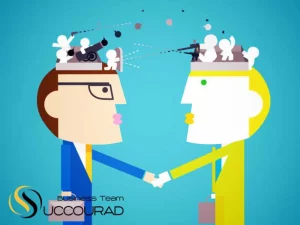
8 strategies for the skill of saying NO
The skill of saying NO is known as one of the most important skills in communication skills, and strengthening it is important and undeniable, especially

Effective leadership depends on the ability to inspire and positively impact people. In preparing for an important meeting – with your staff, leadership team, or clients – you concentrate on what to say, memorize crucial points, and rehearse your presentation so that you will come across as credible and convincing. This is, of course, something you already know.
But did you also know that the people you’re hoping to influence will be subliminally evaluating your credibility, confidence, empathy, and trustworthiness – and that their evaluation will be only partially determined by what you say? Did you know that your use of personal space, physical gestures, posture, facial expressions, and eye contact can enhance, support, weaken, or even sabotage your impact as a leader?
Here are five crucial things that every leader needs to know about body language:
In business interactions, first impressions are crucial. Once someone mentally labels you as “trustworthy” or “suspicious,” “powerful” or “submissive,” everything else you do will be viewed through such a filter. If someone likes you, she’ll look for the best in you. If she mistrusts you, she’ll suspect all of your actions.
While you can’t stop people from making snap decisions – the human brain is hardwired in this way as a survival mechanism – you can understand how to make those decisions work in your favor.
Trust is established through a perfect alignment between what is being said and the body language that accompanies it. If your gestures are not in full congruence with your verbal message, people subconsciously perceive duplicity, uncertainty, or (at the very least) internal conflict.
Neuroscientists at Colgate University study the effects of gestures by using an electroencephalograph (EEG) machines to measure “event related potentials” – brain waves that form peaks and valleys. One of these valleys occurs when subjects are shown gestures that contradict what’s spoken. This is the same brain wave dip that occurs when people listen to nonsensical language.
So, in a very real way, whenever leaders say one thing and their gestures indicate another, they simply don’t make sense. Whenever your body language doesn’t match your words (for example, dropping eye contact and glancing around the room while trying to convey candor, rocking back on heels when talking about the organization’s solid future, or folding arms across chest while declaring openness) your verbal message is lost.
Have you ever noticed that when people are passionate about what they’re saying, their gestures automatically become more animated? Their hands and arms move about, emphasizing points and conveying enthusiasm.
You may not have been aware of this connection before, but you instinctively felt it. Research shows that audiences tend to view people who use a greater variety of gestures in a more favorable light. Studies also find that people who communicate through active gesturing tend to be evaluated as warm, agreeable, and energetic, while those who remain still (or whose gestures seem mechanical or “wooden”) are seen as logical, cold, and analytic.
That’s one reason why gestures are so critical to a leader’s effectiveness and why getting them right in a presentation connects so powerfully with an audience.
I’ve seen senior executives make rookie mistakes. When leaders don’t use gestures correctly (if they let their hands hang limply to the side or clasp their hands in front of their bodies in the classic “fig leaf” position), it suggests they have no emotional investment in the issues or are not convinced about the point they’re trying to make.
In this fast-paced, techno-charged era of email, texts, teleconferences, and video chats, one universal truth remains: Face-to-face is the most preferred, productive, and powerful communication medium. In fact, the more business leaders communicate electronically, the more pressing becomes the need for personal interaction.
In face-to-face meetings, our brains process the continual cascade of nonverbal cues that we use as the basis for building trust and professional intimacy. Face-to-face interaction is information-rich. We interpret what people say to us only partially from the words they use. We get most of the message (and all of the emotional nuance behind the words) from vocal tone, pacing, facial expressions, and other nonverbal cues. And we rely on immediate feedback – the instantaneous responses of others – to help us gauge how well our ideas are being accepted.
So potent is the nonverbal link between individuals that, when we are in genuine rapport with someone, we subconsciously match our body positions, movements, and even our breathing rhythms with theirs. Most interesting, in face-to-face encounters the brain’s ”mirror neurons” mimic not just behaviors, but sensations and feelings as well. When we are denied these interpersonal cues and are forced to rely on the printed or spoken word alone, the brain struggles and real communication suffers.
More business executives are learning not only how to send the right signals, but also how to read them. Peter Drucker, the renowned management consultant, understood this clearly. “The most important thing in communication,” he once said, “is hearing what isn’t said.”
Communication happens over two channels – verbal and nonverbal – resulting in two distinct conversations going on at the same time. While verbal communication is obviously important, it’s not the only message being sent. Without the ability to read body language, we miss crucial elements to conversations that can positively or negatively impact a business.
When people aren’t completely onboard with an initiative, leaders need to be able to recognize what’s happening – and to respond quickly. That’s why engagement and disengagement are two of the most important signals to monitor in other people’s body language. Engagement behaviors indicate interest, receptivity, or agreement while disengagement behaviors signal boredom, anger, or defensiveness.
Recommended Read : What Are the Golden Techniques of Time Management?
leadership is not just about holding a position of power; it involves a complex interplay of skills, traits, and behaviors that enable individuals to guide others effectively toward shared objectives.

The skill of saying NO is known as one of the most important skills in communication skills, and strengthening it is important and undeniable, especially

In this article, we examine 9 common mistakes in negotiation principles and discuss how to avoid them. It can be said that negotiating is an

Sales negotiations can be a source of fear for sellers. But if you are proficient in professional negotiation strategies, you will undoubtedly win. Next, get
Follow The Tutorials and Key Tips.

If you need an experienced Fashion Designer in the Design…
Follow News and Group Discounts.
Follow Trainings and Group Discounts
